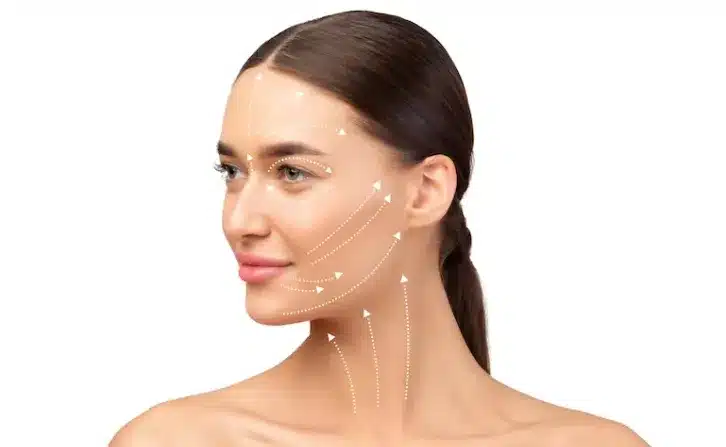Facelift fillers represent a groundbreaking approach in cosmetic surgery, offering non-surgical alternatives for facial rejuvenation. By utilizing injectable fillers, this innovative technique restores volume and contours to the face, effectively addressing signs of aging without the need for invasive procedures. With facelift fillers, individuals can achieve a refreshed and youthful appearance with minimal downtime, making it an increasingly popular choice in the realm of cosmetic enhancement.
How Facelift Fillers Work: Step by Step
Facelift fillers have revolutionized the field of non-surgical cosmetic procedures, offering individuals a chance to achieve a more youthful appearance without the need for invasive surgery. Whether combating the signs of aging or enhancing specific facial features, facelift fillers have become a popular option for those seeking natural-looking results with minimal downtime. In this comprehensive guide, we’ll explore the intricacies of facelift fillers, from the procedure to the benefits, aftercare, risks, and more.
Cosmetic Face surgery, also known as facial plastic surgery, encompasses a range of procedures designed to enhance and rejuvenate various areas of the face. Whether you’re looking to reverse signs of aging or reshape specific features, face surgery offers numerous options to achieve your desired aesthetic goals.
Facelift fillers, also known as dermal fillers or soft tissue fillers, involve injecting various substances into targeted areas of the face to restore volume, smooth wrinkles, and enhance contours. The procedure is typically performed by a qualified medical professional and follows these steps:
Consultation
The process begins with a consultation, during which the individual’s concerns, goals, and medical history are discussed. The practitioner will assess the facial structure and recommend a suitable treatment plan.
Preparation
Before the procedure, the targeted areas are cleansed, and if desired, a topical numbing cream may be applied to minimize discomfort.
Injection
The filler material, often composed of hyaluronic acid, poly-L-lactic acid, or calcium hydroxylapatite, is carefully injected into the predetermined areas using fine needles or cannulas. The practitioner strategically places the filler to achieve the desired results.
Massaging and Evaluation
Once the filler is injected, the practitioner may gently massage the area to ensure even distribution and natural-looking results. The individual’s facial expressions are observed to confirm symmetry.
Results
The results of facelift fillers are usually immediate, and the individual can see the rejuvenated appearance as the treated areas regain volume and smoothness.
Restored Volume
Facelift fillers can effectively restore lost volume in areas such as the cheeks, temples, and under the eyes, creating a more youthful and refreshed appearance.
Smoothing of Wrinkles and Fine Lines
Dermal fillers can help smooth out wrinkles and fine lines, particularly in areas like the nasolabial folds, marionette lines, and around the mouth.
Enhanced Facial Contours
Fillers can be used to enhance facial contours, such as defining the cheekbones or jawline, providing a more sculpted and balanced appearance.
Targeted Areas for Facelift Fillers
Facelift fillers can address various areas of the face, including:
- Cheeks: To restore youthful volume and contour.
- Nasolabial Folds: To reduce lines running from the nose to the mouth.
- Marionette Lines: To minimize lines around the mouth and chin.
- Jawline: To define and enhance the jawline.
- Under-Eye Hollows: To reduce dark circles and hollows beneath the eyes.
- Lips: To add volume and improve lip contours.
Clinic contact number: +989371200167
Types of Facelifts
Facelift surgery, also known as rhytidectomy, encompasses several types of procedures designed to rejuvenate the face by addressing signs of aging such as sagging skin, wrinkles, and facial volume loss. The choice of facelift technique depends on the patient’s unique anatomy, aesthetic goals, and extent of aging concerns. One common type of facelift is the traditional facelift, which involves making incisions along the hairline and around the ears to lift and reposition the underlying tissues, remove excess skin, and create a smoother, more youthful appearance. This procedure is suitable for patients with moderate to severe skin laxity and aging changes in the lower face and neck.
The pursuit of timeless beauty and youthful radiance has led to numerous advancements in the field of cosmetic procedures. One such innovation is the threading facelift, a minimally invasive technique that offers a refreshed and revitalized appearance. Unlike traditional facelift surgeries, threading facelifts provide a non-surgical alternative with reduced downtime and natural-looking results. This article delves into the intricacies of threading facelifts, exploring the procedure, its benefits, aftercare, suitable candidates, potential risks, and more.
Another popular facelift technique is the mini facelift or short scar facelift, which is less invasive than the traditional facelift and targets mild to moderate signs of aging in the lower face and neck. The mini facelift typically involves shorter incisions and less extensive tissue dissection, resulting in reduced downtime and a quicker recovery compared to traditional facelift surgery. Patients with early signs of aging or those seeking subtle improvements may benefit from this approach.
In addition to traditional and mini facelifts, there are specialized techniques such as the deep plane facelift, SMAS facelift, and mid facelift, each addressing specific concerns and targeting different layers of facial tissues. The deep plane facelift, for example, focuses on lifting and repositioning the deeper tissues of the face to achieve more natural and long-lasting results, particularly in the midface and cheek area. The SMAS facelift involves lifting and tightening the superficial musculoaponeurotic system (SMAS) layer, which helps address sagging jowls and neck laxity. The mid facelift targets the middle portion of the face, including the cheeks and under-eye area, to restore volume and improve facial contours. Patients interested in facelift surgery should consult with a board-certified plastic surgeon to discuss their options and determine the most suitable technique based on their individual needs and goals.

10 Benefits of Facelift Fillers
- Non-Surgical Solution: Facelift fillers offer a non-invasive alternative to traditional surgical facelifts.
- Minimal Downtime: Recovery time is usually short, with many individuals returning to regular activities immediately.
- Natural-Looking Results: Skilled practitioners can achieve subtle enhancements that appear natural.
- Quick Procedure: The injections typically take less than an hour, depending on the areas treated.
- Gradual Improvement: Some fillers provide progressive results for a more subtle transformation over time.
- Customizable: Treatment plans can be tailored to address specific concerns and achieve personalized outcomes.
- Temporary Effects: Fillers are not permanent and allow individuals to adjust their treatment as needed.
- Stimulate Collagen: Some fillers stimulate collagen production, enhancing skin texture and elasticity.
- Safe and FDA-Approved: Many fillers are approved by regulatory authorities and considered safe for cosmetic use.
- Boosted Confidence: A refreshed appearance can increase self-esteem and confidence.

Aftercare for Facelift Fillers
After the procedure, it’s essential to follow these guidelines:
- Avoid Touching: Refrain from touching or applying pressure to the treated areas.
- Ice: Applying ice can help reduce swelling and discomfort.
- Avoid Strenuous Activity: For the first 24 hours, avoid intense exercise or activities that could increase blood flow to the face.
- Avoid Alcohol and Blood Thinners: These substances can increase the risk of bruising.
- Sun Protection: Protect your skin from the sun to maintain the results and prevent hyperpigmentation.
Clinic contact number: +989371200167

Best Age for Facelift Fillers and Ideal Candidates
The best age for facelift fillers varies based on individual needs. Generally, individuals in their late 20s to early 60s can benefit from these procedures. Ideal candidates are those who:
- Desire to enhance specific facial features or address signs of aging.
- Have realistic expectations about the outcomes.
- Are in good overall health with no contraindications to the procedure.
The Liquid Facelift is the first real alternative for an surgical lift for faces showing medium to light sagging skin. Administering injectable fillers freshens up the whole face. Body Clinicm

Risks of Facelift Fillers
- Bruising and Swelling: Common side effects usually subside within a few days.
- Infection: Although rare, there is a small risk of infection at the injection sites.
- Allergic Reactions: Some individuals might experience allergic reactions to the filler material.
- Uneven Results: Poor injection technique could lead to uneven filler distribution.
- Migration: The filler material might move from the injection site to unintended areas.
- Necrosis: In rare cases, blood flow can be compromised, leading to tissue death.
- Granulomas: Small nodules might form under the skin as a reaction to the filler.
- Temporary Discomfort: Mild pain or discomfort might be experienced after the procedure.
- Longevity Variability: The duration of results varies depending on the filler used and individual factors.
- Rare Complications: Extremely rare risks include blindness (if filler enters a blood vessel) or anaphylactic shock.
The Role of Facelift Fillers in Modern Dermatology
In the realm of cosmetic enhancement and dermatology, the application of facelift fillers has seen remarkable advancements, propelled by rigorous research and development. Institutions like Harvard University and Stanford University have been at the forefront, contributing significantly to the field through clinical studies and innovations.
Esteemed professionals such as Dr. Jean Carruthers and Dr. Steven Fagien have pioneered techniques and applications in the use of botulinum toxin and hyaluronic acid fillers, respectively, shaping the standards of non-surgical facial rejuvenation. These contributions have not only enriched the academic discourse but have also enhanced the practical approaches to facial aesthetics, demonstrating a blend of science and artistry in dermatology.
Allergan, a global pharmaceutical giant, has emerged as the most active company in the field of facelift fillers, thanks to its flagship product, Juvéderm, among others. The company’s relentless pursuit of excellence and innovation in dermal fillers has set new benchmarks for safety, efficacy, and patient satisfaction. Recent statistics reveal a surge in the adoption of non-surgical facelift procedures, with the American Society of Plastic Surgeons reporting over 3 million procedures involving soft tissue fillers in the last year alone, indicating a robust growth rate of over 10% year-over-year.
This uptick reflects a growing consumer preference for minimally invasive aesthetic treatments, underscored by advancements in filler technology, including the development of Vycross technology that enhances the longevity and natural appearance of filler applications, and the incorporation of lidocaine in fillers for a more comfortable patient experience.
Sarah Jessica Parker Getting a Facelift
When And Just Like That… was announced in 2021, Sarah Jessica Parker spoke to Vogue about women and aging—and the inevitable discourse that comes with that reality: “I know what I look like. I have no choice. What am I going to do about it? Stop aging? Disappear?” During a recent appearance on The Howard Stern Show, Parker echoed the same sentiment when asked about her plastic surgery preferences—though with one surprising, if not relatable, caveat.
“You know, I missed out on the facelift,” says Parker. “Like an old-fashioned good one that you have when you’re like 44.” Instead of invasive procedures or injectables like Botox, Parker enjoys regular visits to the dermatologist with less-invasive treatments, like peels, to achieve her brand of glow. Her penchant for the natural makes sense: Parker’s luminosity has always seemed to come from a certain sense of self, the kind of confidence which draws eyes that can’t look away. But make no mistake: she’s not poo-pooing cosmetic procedures if that’s your thing.

Summary
In conclusion, facelift fillers emerge as a transformative solution in the landscape of cosmetic surgery, presenting a non-invasive avenue for facial rejuvenation. Through the strategic use of fillers, individuals can combat the visible signs of aging and achieve a refreshed, youthful appearance without undergoing traditional surgical procedures. Moreover, beyond their immediate effects, these fillers also stimulate collagen production, contributing to long-term improvements in skin quality and elasticity, thereby addressing the underlying mechanisms of facial aging. By harnessing the power of fillers, individuals can reclaim their confidence and defy the passage of time, making facelift fillers a compelling option for those seeking natural-looking and enduring results in facial rejuvenation.
Clinic contact number: +989371200167
FAQs
1. Are facelift fillers permanent?
Facelift fillers are not permanent. The duration of results varies depending on the filler used, metabolism, and other factors.
2. Can I combine facelift fillers with other treatments?
Many individuals combine facelift fillers with cosmetic treatments like Botox or laser therapies for comprehensive rejuvenation.
3. What is the difference between a facelift and fillers?
A facelift and fillers are both cosmetic procedures used to address signs of aging in the face, but they work in different ways. A facelift, also known as rhytidectomy, is a surgical procedure that involves lifting and tightening the skin and underlying tissues to reduce sagging and wrinkles. It is typically recommended for patients with significant skin laxity and deep wrinkles. In contrast, fillers, also known as dermal fillers or soft tissue fillers, are non-surgical injectable treatments used to add volume, smooth wrinkles, and enhance facial contours. Fillers can be used to address fine lines, wrinkles, hollow areas, and volume loss in various areas of the face, providing a more youthful appearance without the need for surgery.
4. What types of fillers are available for facial rejuvenation?
There are several types of fillers available for facial rejuvenation, each with unique properties and indications. Hyaluronic acid (HA) fillers, such as Juvéderm and Restylane, are among the most popular and widely used fillers. HA fillers are naturally found in the body and provide hydration, volume, and structure to the skin. Other types of fillers include calcium hydroxyapatite (e.g., Radiuses), poly-L-lactic acid (e.g., Sculptra), and polycaprolactone (e.g., Elanese), each with its own set of characteristics and duration of effects. During a consultation, a qualified injector can assess the patient’s concerns and goals and recommend the most suitable filler or combination of fillers to achieve the desired results.
5. What should I expect during and after filler treatment?
The filler treatment process typically involves a consultation with a qualified injector to discuss the patient’s goals, assess their facial anatomy, and develop a personalized treatment plan. During the procedure, the injector will administer the filler using a fine needle or cannula to target specific areas of concern. Most filler treatments are well-tolerated, and patients may experience mild discomfort or temporary swelling and bruising at the injection sites, which usually resolve within a few days. Results from filler treatments are typically immediate and may last anywhere from several months to over a year, depending on the type of filler used and individual factors such as metabolism and lifestyle. It’s essential to follow any post-treatment instructions provided by the injector and attend follow-up appointments as recommended to ensure optimal results and satisfaction with the outcome of the treatment.
Liquid facelift- Facelift without surgery | The Body Clinic
https://www.vogue.com/article/sarah-jessica-parker-plastic-surgery-facelift



